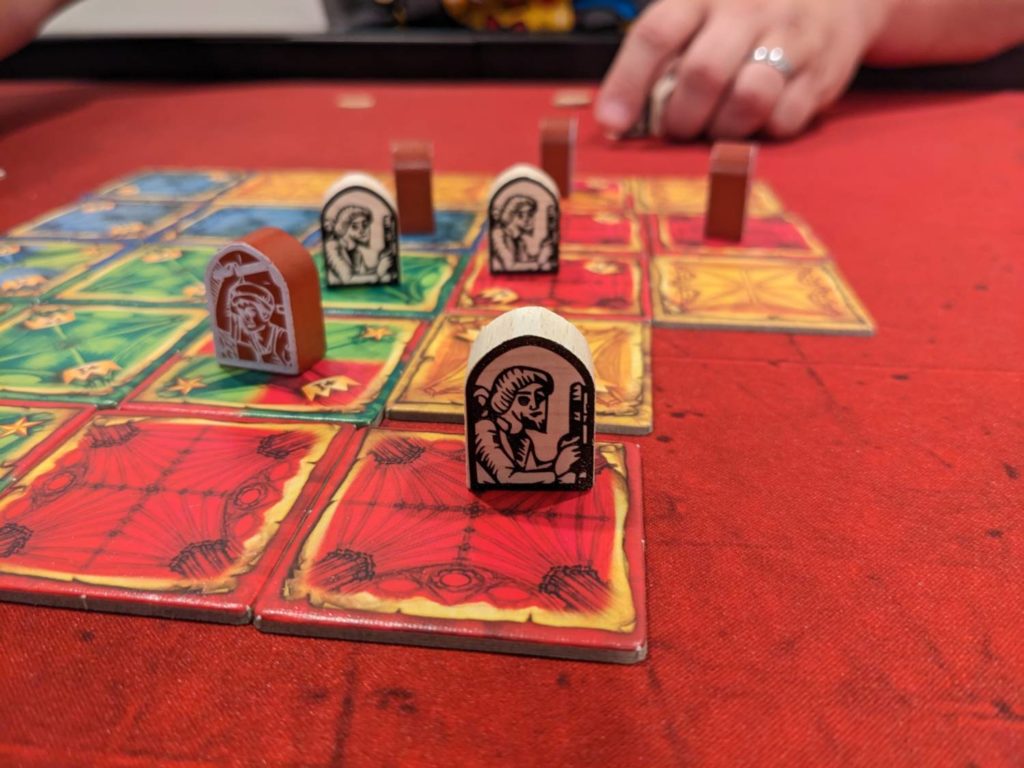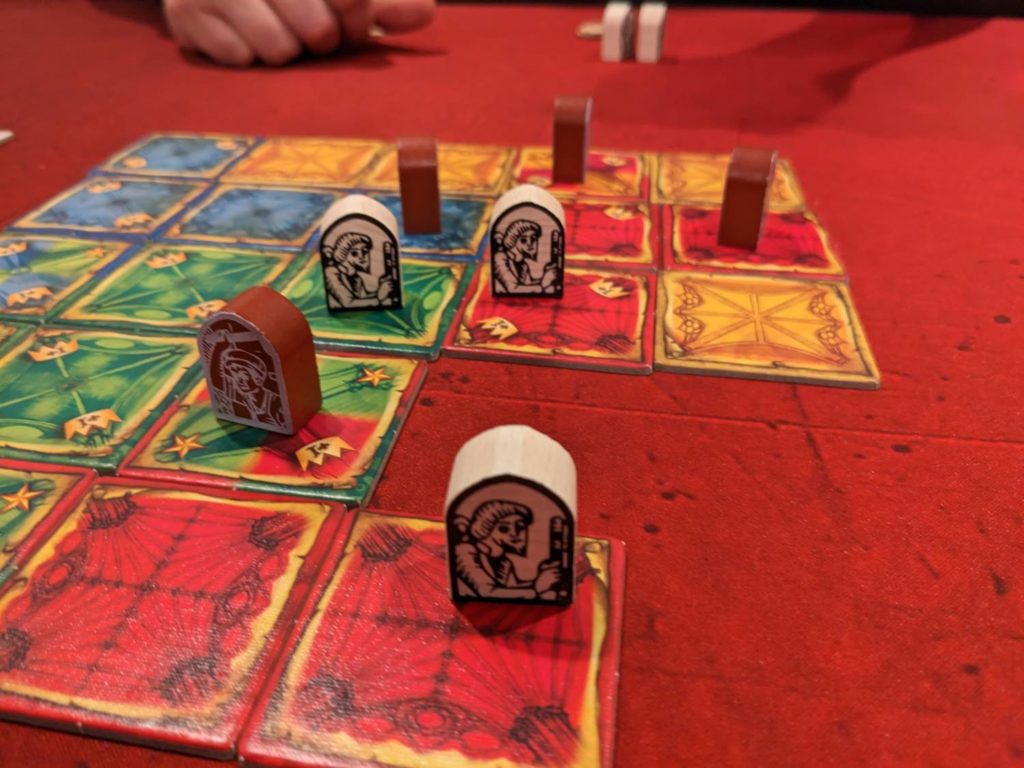Disclosure: Meeple Mountain received a free copy of this product in exchange for an honest, unbiased review. This review is not intended to be an endorsement.
“Here’s a copy of Basilica,” said Joanna, our international contact at Portal Games, during SPIEL 2022 last October. “Just know that this one is sometimes a little mean.”
Then she handed me a copy of the game. When I flipped the box over to look at the component list, there it was, printed in plain view:
“Basilica. A tight, clever, and often…mean 2-player duel!”
So, Joanna said it was mean, and the box says it was mean (one assumes the game’s designer, Lukasz M. Pogoda, also thinks that it is mean), so it probably IS mean, right?
Right. Basilica, a 2010 game re-released by Portal along with a small expansion included in the new edition, is not going to be for everyone. I’m actually fine with mean, but my wife is not, and I’m going to have to play this with my wife because she is always one of the victims of my two-player-only experiences.
How did that go?

Oh Boy
Basilica’s rules have not changed since the 2010 version was released. Two competing master architects are tasked with building a single cathedral in Florence; by the end of play, only one architect can be recognized for their hard work (“collaborations” were apparently not an option), and the winner will be “generously rewarded,” per the rulebook.
Even though building a cathedral is the game’s goal, the reality feels a bit different: tiles will be added to a tableau representing the cathedral, but the building is never actually going to be completed. At some point, you simply stop building it.
The game can end one of two ways: when the tile draw pile is exhausted twice, or if three scoring rounds are completed. (I still haven’t played a game yet where the tiles ran out, so scoring rounds is the more likely end-game trigger.)
Near the five-tile-wide building area, a market of double-sided tiles awaits. On the top half of the market, three tiles are available on their Order side, which feature chances for players to mess with their opponent. (Orders really only exist for this purpose.) The bottom half of the market has three tiles on their cathedral sides, which can be placed as “vaults” in the cathedral. To begin play, each architect starts with five builder pawns, which can be used to secure area majorities with the tiles built into the cathedral.
During each turn, an architect must take three of the possible actions. They can either place a vault in the cathedral, place a builder pawn (immediately after placing a vault on that same tile), or execute an order.
Placed vaults have to be orthogonally adjacent to at least one other tile unless it goes in the first row used in each game. The vaults come in four colors along with two-color wild tiles. When placing a wild vault, it can’t be placed next to another wild.
Executing an order gives players a chance to move builder pawns to different tiles, to break up contiguous sections of the cathedral, or to use other powers. Some of the orders grant players chances to promote one of their builders, which may double the score for a section of the cathedral or provide a tie-breaker advantage during scoring.
When a scoring takes place, all that matters is area majority. The architect with the most builder pawns in an orthogonally-connected colored tile section gets one point for each tile of that color. If you have a section of eight yellow tiles adjacent to each other, that section will score eight points. If you are the opposing architect and have builder pawns in that section, the loser will get one point for each of their pawns in that section.
After sections are scored, play continues until one of the game’s end-game triggers is met.

Do, Then Undo
You know how some games have rules that dictate players cannot undo a player’s previous turn? Basilica looks at rules like that and laughs out loud.
You are going to have a few turns in Basilica where you’ll have done something to move pawns around, or build out a part of the cathedral, only to watch your opponent undo as much of that as possible. Maybe they will use an order to move one of your architects out of the highest-scoring section of the cathedral. Maybe they will add one of their pawns to ensure that the total number of pawns in a section is even, forcing that section to score zero points during the next scoring phase. Occasionally, you’ll promote a pawn in a section to the same level as an opposing pawn, which means that the bonuses derived from those promoted pawns cancel each other’s powers.
Basilica seems to take pleasure in watching one player attack the other, without some of the Kemet: Blood and Sand elements of a true area control wargame. (I prefer the Kemet miniatures over the builder pawns in Basilica.)
Basilica does have some slick moments, particularly when finding a way to maximize scoring then rushing the game into a scoring round. Some of the vault tiles have a crown printed in the corners. When these vaults are placed in the cathedral, that moves a neutral pawn one space closer to another scoring. Seasoned players will find ways to use an order to double the value of a scoring section by promoting a builder in that section, then placing a vault with crowns on it to edge into the scoring phase before they can be snaked by their opponent.
Turns like this can be fun. But these moments are overshadowed by the more monotonous turn-taking of the game. More often, I find that players will skip messing with their opponent in favor of placing vault tiles to increase a section and hopefully score it before someone comes in and messes up their plans.
Basilica is not helped by the fact that it is essentially an abstract experience—it never once feels like you are building a cathedral. Fact: the cathedral is never finished. You just…stop. With no architectural design to adhere to, you’re just adding tiles until you meet one of the end-game triggers. Was it ever a consideration to have the cathedral look a certain way? Maybe incentivize each architect with a secret building plan card, so they make more points at the end of play by leaning hard into a single color??
These are the kinds of questions that baffle me when games hit my table. Another: why can’t I wipe the market of the existing tile choices? More: some of the order powers do things like push a builder pawn into an adjacent tile. How does this make sense when considering the game’s theme? It’s like I used a bull rush action from a game like Gloomhaven or Hoplomachus to shove another player out of the way, but I thought I was here to design a cathedral!!
One of the orders is called “Confuse.” The active player takes one of their pawns off of a tile, which actually makes sense—sometimes, you have a pawn in a section that won’t score well when the time comes. But instead of being able to relocate that same pawn elsewhere, you move an opposing pawn one orthogonally-adjacent space.
So now I’m the one who is confused. You’re saying that by sacrificing one of my pawns, I get to “mind meld” another pawn into moving one space in any direction. Wouldn’t it make more sense to sacrifice one of my own to sacrifice one of theirs? Or would it make more sense to not have this order in the game at all?
Also, each player is given a single coin to use when they want to take a “Paid Order” action. This allows a player to follow their opponent’s order execution action by giving their opponent the coin to partially undo their action. Then, that player’s coin stays with the opponent until they spend it back. But what if the player who has two coins never spends them? There’s no real economy in Basilica, so why is it a coin at all?

Try Before You Buy
Basilica ended up in the toughest of places for me: just above average, but nothing exceptional.
In each game, someone scores a section in a way that seems pretty satisfying. And, in each game, I was able to stab my opponent in the gut while also getting stabbed back a couple times. For some, this is the kind of game they’ll be looking for, in an environment that isn’t truly mean, but it is continuously inconvenient as plans get derailed over and over again.
For those who are wondering: no, my wife didn’t enjoy Basilica. To her credit, she recognizes that some couples really like that kind of back-and-forth affair with their partner. Maybe you’ve got a roommate who you play games with all the time; if so, and you enjoy area control games, Basilica is worth a look.
Otherwise, I think there are other two-player-only games worth considering instead. Now that I’m thinking about it, I’m going to set up one of my favorites right now.












Add Comment